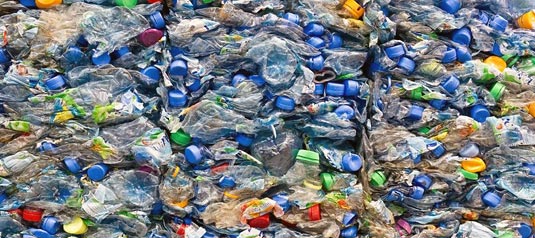Novel recycling methods: The fluorescent fingerprint of plastics

Photo: Alterfalter / Fotolia.com
A team of researchers led by Professor Heinz Langhals of LMU’s Department of Chemistry has taken a significant step which promises to markedly expedite the recycling of plastic waste. They have developed a technique which provides for automated recognition of their polymer constituents, thus improving the efficiency of recycling and re-use of the various types of plastic.
The technique takes advantage of the polymer-specific nature of the intrinsic fluorescence induced by photoexcitation. “Plastics emit fluorescent light when exposed to a brief flash of light, and the emission decays with time in a distinctive pattern.
Thus, their fluorescence lifetimes are highly characteristic for the different types of polymers, and can serve as an identifying fingerprint,” Langhals explains. Details of the new method appear in the latest issue of the journal “Green and Sustainable Chemistry”.
The new technique, which is the subject of a patent application, involves exposing particles of plastic to a brief flash of light which causes the material to fluoresce. Photoelectric sensors then measure the intensity of the light emitted in response to the inducing photoexcitation to determine the dynamics of its decay.
Because the different polymer materials used in the manufacture of plastics display specific fluorescence lifetimes, the form of the decay curve can be used to identify their chemical nature. “With this process, errors in measurement are practically ruled out; for any given material, one will always obtain the same value for the fluorescence half-life, just as in the case of radioactive decay,” says Langhals.
Turning bottles into windcheaters
Unlike metals, the quality of which often suffers during the recycling process itself, recycled plastics can be processed quite efficiently. “Polymers represent an interesting basis for the sustainable cycling of technological materials. The crucial requirement is that the recycled material should be chemically pure. In that case, bottles made of PET, for example, can be relatively easily turned into synthetic fiber for use in waterproof windcheaters,” says Langhals.
The vast majority of technical polymers are processed as thermoplastics, i.e., they are melted at high temperature and the finished article is produced by injecting the molten material into an appropriate mold, where it allowed to set. Reheating of recycled plastic can, however, lead to deleterious alterations in its properties of the material unless the sorted material is of high purity.
Contamination levels as low as 5% are sufficient to significantly reduce the quality of the reformed product. The reason for this “down-cycling” effect is that, as a general rule, polymers tend to be immiscible, as they are chemically incompatible with one another.
Remelting of polymer mixtures therefore often leads to partitioning of the different polymers into distinct domains separated by grain boundaries, which compromises the quality of the final product. For this reason, high-quality plastics are always manufactured exclusively from pristine precursors – never from recycled material.
The new method developed by the LMU team could, however, change this. “The waste problem can only be solved by chemical means, and our process can make a significant contribution to environmental protection, because it makes automated sorting feasible,” says Langhals. Indeed, the use of fluorescence lifetime measurements permits the identification and sorting of up to 1.5 tons of plastic per hour. In other words, the method in its present form already meets the specifications required for its application on an industrial scale.
(Green and Sustainable Chemistry, 2014)
Media Contact
All latest news from the category: Ecology, The Environment and Conservation
This complex theme deals primarily with interactions between organisms and the environmental factors that impact them, but to a greater extent between individual inanimate environmental factors.
innovations-report offers informative reports and articles on topics such as climate protection, landscape conservation, ecological systems, wildlife and nature parks and ecosystem efficiency and balance.
Newest articles

High-energy-density aqueous battery based on halogen multi-electron transfer
Traditional non-aqueous lithium-ion batteries have a high energy density, but their safety is compromised due to the flammable organic electrolytes they utilize. Aqueous batteries use water as the solvent for…

First-ever combined heart pump and pig kidney transplant
…gives new hope to patient with terminal illness. Surgeons at NYU Langone Health performed the first-ever combined mechanical heart pump and gene-edited pig kidney transplant surgery in a 54-year-old woman…

Biophysics: Testing how well biomarkers work
LMU researchers have developed a method to determine how reliably target proteins can be labeled using super-resolution fluorescence microscopy. Modern microscopy techniques make it possible to examine the inner workings…





















